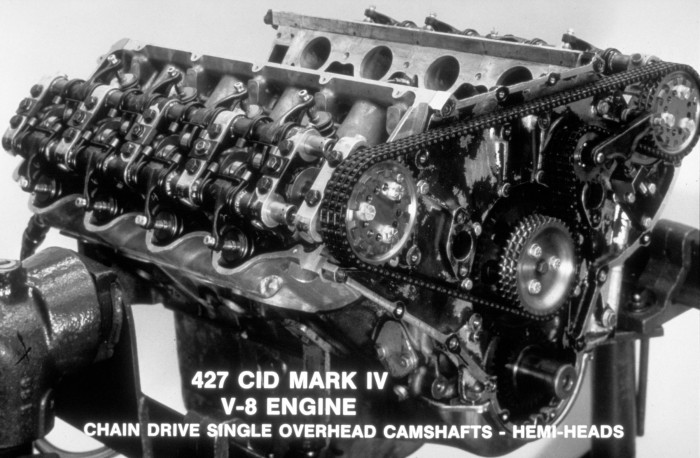Lost and Found overflow – Chevrolet’s overhead-camshaft and hemi-headed big-block V-8s
Posted on May 6, 2014 in Featured | 2 comments

While researching our recent story on the 50th anniversary of the Mark IV big-block Chevrolet V-8, we came across something odd, something we’d never seen before – and it appears not many other people had seen it before either. Two photos in the GM Media database that showed two experimental big-blocks that very well could have set the American high-performance scene on its ear, had they been developed: one of a single overhead-camshaft hemi-headed 427, another of a fuel-injected hemi-headed big-block with pushrods.
Neither of the photos appear in any of our searches, and a few days of searching led only to vague mentions here and there about Zora Arkus-Duntov and Chevrolet taking a crack at single overhead-camshaft, double overhead-camshaft, and hemi-headed versions of both the big-block and small-block in the mid- to late 1960s. No photos, no links to direct sources, just mentions of old magazine articles.
GM itself wasn’t able to provide much more information. Corvette historian and author Ken Kaiser shed a little more light on the engines in the photos; according to Ken, they depict 1966-1967 vintage big-blocks, and the work order number stamped into the hemi-headed engine – 28451-20-A – denotes the first (and likely only) engine of its kind. The blockoff plate on the single overhead-camshaft engine above suggests it was meant to carry a fuel injection system of some sort, possibly the same or similar to the one we see on the hemi-headed engine below.
The triple-row timing chain above looks rather stout (and not nearly as long as the Ford SOHC 427’s seven-foot timing chain) and appears as though it would have resided under a cover that encompassed the entire front of the engine, though we don’t see in the photo any direct connection between the crankshaft and the camshafts, and we’d have to wonder whether the cover and the chain would interfere with the water pump. The shaft-mounted valvetrain appears fairly straightforward and those huge intake ports look like a direct shot into the combustion chamber.
UPDATE: McGean pointed out that there is a direct connection between the crankshaft and camshaft – it’s just really hard to see those dark gears sunk into the front of the engine. He also points out that the entire plate behind the timing chain appears to bolt to the existing holes for the regular (OHV) Mark IV timing chain cover, which would indicate that this whole unit was designed to bolt on to an unmodified Mark IV block.

This shot of the pushrod-activated hemi-headed design appears to show a somewhat complicated setup with the intake valves actuated directly by the camshaft, but the exhaust valves actuated by a set of intermediary pushrods. Where we’d expect to see holes for the spark plugs in the middle of the cylinder head, as on a Chrysler Hemi (and it looks like they’d have enough space there), we see only what appears to be untapped bosses of some sort. For that matter, we don’t see any place in the single overhead-camshaft heads for spark plugs either. That mechanical fuel-injection system looks pretty killer, though.
This was about the same time Oldsmobile was experimenting with its W-43 and OW-43 hemi-headed V-8s, and those experimental engines look remarkably similar to these two. Undoubtedly, Chevrolet in particular – and GM’s engineers as a whole – were feeling some pressure from Chrysler’s Hemi 426, introduced in 1964, and Ford’s FE-series 427s, including the SOHC, which was introduced in 1965. Whether these Mark IV big-blocks were meant to compete with Ford and Chrysler on the street or just on the race track, we can only speculate.
As for their ultimate fates and why Chevrolet decided not to go down this particular road, nobody we’ve spoken with seems to know.







.gif)


At sunset it is about the money, and that looks to be one hell of an expensive motor to build for production cars and why it likely never came to be.
When GM finally got around to building a competitive overhead cam V8 in 1992 is was a few sandwiches short of a picnic. Perhaps our memories were better served with the Fred Flintstone pushrod Mk II motor many of us worship.
US auto producers owned the high torque pushrod V8 business, but exotic overhead and multiple cam motors, not really.
Danny Plotkin
Why did they allow the Northstar to be born a flawed platform? My own anecdotal experience says these are literally a crapshoot as to whether you get a good one or a lemon. Yet of the Aurora 4.0 DOHC V8 I have never heard of HG failure. I remember being blown away by 281 cubic inches and 300 honest horses. With a very un-small block like power curve. I guess it just shows the law of unforeseen consequences. It reminds me of the tradeoff of timing belt vs. chain. Would I pay $500 more for a car to last twice as long w/o a change? From a new buyer with a four year ownership expectation, probably not. Yet the reputation that cars get as good vs. bad usually is earned from 7-10 years of age and 100k miles and up. The Sophie’s choice of the car world.